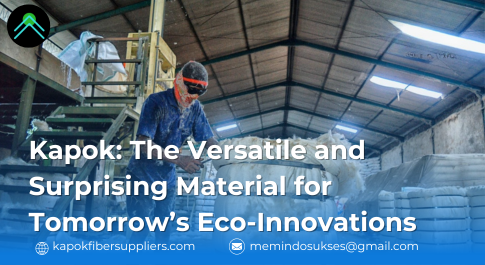
Kapok: The Versatile and Surprising Material for Tomorrow’s Eco-Innovations
When we think about sustainable materials, we often envision options like bamboo, hemp, or organic cotton. But there’s a lesser-known yet highly promising natural fiber that could revolutionize various industries: kapok. This soft, buoyant fiber, derived from the seed pods of the Ceiba pentandra tree, is gaining attention for its incredible eco-friendly qualities. And as we increasingly look for alternative solutions in everything from textiles to packaging, kapok may just be the versatile hero we need.
In this article, we will explore how kapok is not only a sustainable material but also an untapped resource with surprising potential for the future.
What Makes Kapok Stand Out?
Kapok is not your average plant fiber. While it shares similarities with cotton in texture, it has unique qualities that make it especially valuable in eco-conscious design. The fiber is harvested from the pods of the Ceiba pentandra, a tall, majestic tree found primarily in tropical regions. Unlike cotton or other traditional fibers, kapok is lightweight, extremely buoyant, and inherently water-resistant. These properties make it ideal for a wide range of uses, especially where moisture resistance is essential.
How Kapok Differs from Other Fibers
Many of us are familiar with the importance of choosing eco-friendly alternatives to synthetic fibers. Kapok offers distinct advantages in this respect:
1. Natural Buoyancy
Kapok is famously buoyant. In fact, it has been used for decades as a filling for life vests and flotation devices. Unlike synthetic materials like foam, which are petroleum-based and non-biodegradable, kapok is a natural option that doesn’t rely on toxic chemicals. Its ability to float on water makes it ideal for eco-friendly outdoor gear, emergency supplies, and even products like water-resistant outdoor cushions.
2. Inherent Moisture Resistance
Kapok fibers have a natural resistance to moisture, mold, and mildew. This makes them especially useful for items that are exposed to humid conditions, such as pillows, mattresses, and even camping equipment. In places where traditional fibers like cotton or synthetic foam would quickly degrade in damp environments, kapok holds up better and lasts longer without requiring toxic treatments.
3. Superlight Weight
One of the most notable features of kapok is its extraordinary lightness. The fiber is hollow and filled with air, which gives it a light, fluffy texture. As a result, products made from kapok are lightweight without sacrificing comfort. This makes it perfect for applications in travel products, lightweight bedding, and even clothing, where weight is a critical factor.
Eco-Friendly Harvesting and Minimal Processing
Unlike many industrial materials, kapok requires very little in terms of processing or chemical treatment. The fiber is collected from the seed pods when they naturally split open, making the process minimally invasive. The fibers are separated from the seeds by hand, and the cleaning process typically involves only a simple washing. This significantly reduces the energy and water required to bring the material to market.
Additionally, kapok trees grow quickly and are often cultivated in areas that don’t require deforestation. In this way, kapok supports regenerative practices by encouraging the growth of large, fast-growing trees that can help restore depleted ecosystems.
Where Kapok is Already Making an Impact
1. Sustainable Bedding and Mattresses
The global bedding industry is notorious for its use of synthetic materials and chemical treatments. Kapok is making inroads into this market by offering a natural, hypoallergenic, and eco-friendly alternative. Kapok-filled pillows, duvets, and mattresses are becoming increasingly popular, as they are free from the chemicals found in traditional bedding materials like memory foam or down feathers.
2. Eco-Friendly Packaging Solutions
In a world where plastic waste is a growing concern, kapok’s natural properties could revolutionize the packaging industry. Its buoyancy, resilience, and biodegradability make it an excellent candidate for packing materials. Companies looking to reduce their environmental footprint can use kapok as an alternative to Styrofoam and other non-biodegradable packaging options. Kapok packaging could be used for everything from fragile items to environmentally-conscious shipping solutions.
3. Sustainable Fashion: The Future of Insulation
Kapok’s insulating properties are also catching the eye of the fashion industry. While synthetic down has long been the go-to material for warm jackets and coats, kapok is emerging as an eco-friendly alternative. Kapok fibers can be processed to mimic down feathers, offering warmth without animal cruelty or the environmental impact of synthetic fills. As more fashion brands move toward sustainable collections, kapok is positioned to play a key role in the future of eco-conscious fashion.
4. Natural Textiles for Furniture
In the furniture industry, kapok is beginning to replace synthetic fibers in cushions, upholstery, and mattresses. The natural resilience of kapok makes it an ideal material for comfortable and durable home furnishings. Unlike synthetic alternatives, kapok can be fully composted at the end of its life cycle, reducing landfill waste.
The Untapped Potential of Kapok in Advanced Industries
While kapok is already making waves in consumer goods, its full potential remains largely unexplored in more advanced industries. Here are a few areas where kapok could disrupt current practices:
1. Biomedical Applications
Kapok’s inherent softness and hypoallergenic properties make it a potential candidate for medical products, including bandages, wound dressings, and surgical materials. Its biocompatibility and natural antibacterial properties could make it an ideal material for sensitive medical applications where natural alternatives are in high demand.
2. Construction and Insulation
Given its buoyancy and thermal properties, kapok could also be used in construction, especially in areas that require insulation materials. Kapok fibers are naturally resistant to water and mold, making them suitable for use in building homes and structures in humid, tropical climates. As a renewable material with low processing costs, kapok could contribute to more sustainable building practices in regions around the world.
3. Bio-Plastics and Composites
With the growing need for biodegradable plastics, kapok is being explored as a raw material for bio-composites. When combined with other plant fibers, kapok could create lightweight, strong, and biodegradable alternatives to conventional plastics. These materials could find applications in everything from packaging to automotive parts, providing a greener alternative to petroleum-based plastic products.
The Road Ahead: Overcoming Challenges for Broader Adoption
While kapok shows immense promise, there are still challenges to its wider adoption. The supply chain for kapok remains relatively small, and the production of high-quality fibers in large quantities is still developing. Additionally, kapok’s natural properties—while advantageous in many cases—can make the fiber difficult to work with in some industries that require high strength or durability.
However, with increasing interest in sustainable materials, research and innovation in the processing of kapok are expected to grow. With the right investments in technology, the scalability of kapok-based products could expand rapidly, making it more accessible to mainstream industries.
Conclusion: Why Kapok Should Be on Your Radar
Kapok may be a hidden gem in the world of sustainable materials, but its remarkable qualities make it a material to watch. From its natural buoyancy and water resistance to its minimal environmental footprint, kapok offers a wide range of potential uses that could benefit both consumers and the planet.
As industries continue to shift toward sustainability, kapok could become a major player in reducing our reliance on synthetic materials and promoting eco-friendly design. Whether used in textiles, packaging, construction, or even medical applications, kapok has the potential to redefine how we think about materials and innovation in the 21st century.
As we embrace the future of sustainability, kapok is a fiber worth championing—and it’s only just beginning to show what it can do.
Contact us :
☎️ : +6285933133244
📍 : Jl.Ir Soekarno, No.122, Dadaprejo, Junrejo, Kota Batu, East Java 65323

